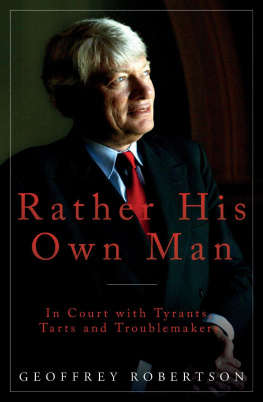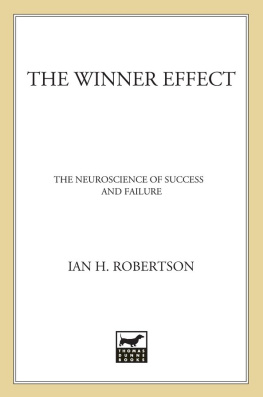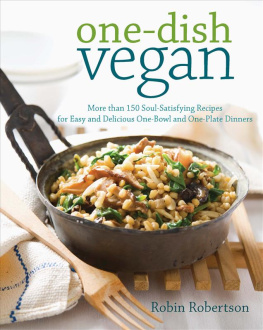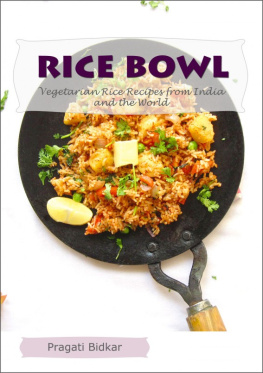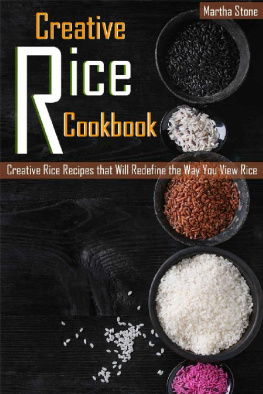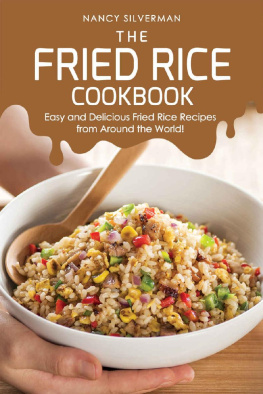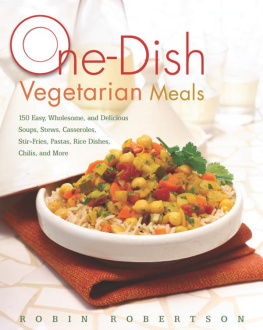Robertson - Rice and Spice: 100 Vegetarian One-Dish Dinners Made with the Worlds Most Versatile Grain
Here you can read online Robertson - Rice and Spice: 100 Vegetarian One-Dish Dinners Made with the Worlds Most Versatile Grain full text of the book (entire story) in english for free. Download pdf and epub, get meaning, cover and reviews about this ebook. publisher: Houghton Mifflin, genre: Home and family. Description of the work, (preface) as well as reviews are available. Best literature library LitArk.com created for fans of good reading and offers a wide selection of genres:
Romance novel
Science fiction
Adventure
Detective
Science
History
Home and family
Prose
Art
Politics
Computer
Non-fiction
Religion
Business
Children
Humor
Choose a favorite category and find really read worthwhile books. Enjoy immersion in the world of imagination, feel the emotions of the characters or learn something new for yourself, make an fascinating discovery.
- Book:Rice and Spice: 100 Vegetarian One-Dish Dinners Made with the Worlds Most Versatile Grain
- Author:
- Publisher:Houghton Mifflin
- Genre:
- Rating:4 / 5
- Favourites:Add to favourites
- Your mark:
- 80
- 1
- 2
- 3
- 4
- 5
Rice and Spice: 100 Vegetarian One-Dish Dinners Made with the Worlds Most Versatile Grain: summary, description and annotation
We offer to read an annotation, description, summary or preface (depends on what the author of the book "Rice and Spice: 100 Vegetarian One-Dish Dinners Made with the Worlds Most Versatile Grain" wrote himself). If you haven't found the necessary information about the book — write in the comments, we will try to find it.
Rice and Spice: 100 Vegetarian One-Dish Dinners Made with the Worlds Most Versatile Grain — read online for free the complete book (whole text) full work
Below is the text of the book, divided by pages. System saving the place of the last page read, allows you to conveniently read the book "Rice and Spice: 100 Vegetarian One-Dish Dinners Made with the Worlds Most Versatile Grain" online for free, without having to search again every time where you left off. Put a bookmark, and you can go to the page where you finished reading at any time.
Font size:
Interval:
Bookmark:
The Harvard Common Press
535 Albany Street
Boston, Massachusetts 02118
www.harvardcommonpress.com
Copyright 2000 by Robin Robertson
Illustrations copyright 2000 by Brooke Scudder
All rights reserved. No part of this publication may be reproduced or transmitted in any
form or by any means, electronic or mechanical, including photocopying, recording, or any
information storage or retrieval system, without permission in writing from the publisher.
Printed in the United States of America
Printed on acid-free paper
Library of Congress Cataloging-in-Publication Data
Robertson, Robin (Robin G.)
Rice and spice : 100 vegetarian one-dish dinners made with the
world's most versatile grain / Robin Robertson.
p. cm.
Includes bibliographical references and index.
ISBN 1-55832-159-4 (cloth : alk. paper)ISBN 1-55832-160-8 (pbk. : alk. paper)
1. Cookery (Rice) 2. Vegetarian cookery. 3. Entres (Cookery) I. Title.
TX809.R5 R627 2000
641.6'318dc21 99-057901
Special bulk-order discounts are available on this and other Harvard Common Press books.
Companies and organizations may purchase books for premiums or for resale, or may
arrange a custom edition, by contacting the Marketing Director at the address above.
Cover photograph by Rita Maas
Cover design by Suzanne Noli
Text design by Barbara M. Bachman
Illustrations by Brooke Scudder
10 9 8 7 6 5 4 3 2
This book is dedicated to
John Robbins, for being
an inspiration and a light
I wish to acknowledge the talented chefs who have shared their rice specialties with me over the years, especially Bill Stacks, who first taught me how to cook perfect rice. Special thanks to my husband, Jon Robertson, for his assistance and support, and to my tasters, testers, and friends Samantha Ragan, Lochlain Lewis, Gloria Siegel, John Mein, B. J. Atkinson, and Pat Davis. I also want to thank Arielle Eckstut and Dan Rosenberg for encouraging me in this project, and the staff at The Harvard Common Press.
The simple flavor of a steaming bowl of white rice can be delicious on its own. But add some spices, a sauce, or other ingredients to tantalize the taste buds, and that simple bowl of rice can become a transporting experience. Combined with savory companions, rice readily complements the flavors surrounding it to create meals of unlimited variety. The taste and aroma of global seasonings can even evoke exotic images.
Throughout the world, from village huts to four-star restaurants, one can find transcendent rice dishes, prepared to perfection, punctuated by a wide choice of seasonings. The perfect rice dish can just as easily be the fluffy white rice of a favorite Chinese restaurant crowned with Szechwan string beans or freshly cooked basmati topped with a pungent vegetable vindaloo created in your own kitchen.
Just try choosing between the toothsome creaminess of a silky risotto and the haunting fragrance of jasmine rice steaming up through a fiery Thai curry. Or between a fruity Middle Eastern pilaf and a bowl of lusty jambalaya. And then there are times when even the best savory dish can't live up to the comforting memory of Mom's rice pudding, christened with cinnamon.
What constitutes a perfect dish of rice varies with each rice tradition, in every country where rice is eaten, for each variety of rice has its own flavor and textural characteristics. Whether I am savoring a rich curry-topped basmati spiced with cloves and cinnamon, marveling at the simplicity of a bowl of Japanese sticky rice scattered with jewel-like vegetables, or scooping up the last morsel of rice drenched with a robust Moroccan tagine, I find that I adore ricebut this has not always been so.
When I was growing up in the 1950s, rice made infrequent appearances on our dinner table. In that post-World War II era, few families strayed from the American diet pattern of meat, potatoes, and a token vegetable side dish. In my Italian-American household, pasta would replace the meat and potatoes at least twice a week, but rice was a stranger. On those rare occasions when we did have rice, it was a less than memorable side dish. My mother was a fabulous cook, but her rice, like that of countless other home cooks at the time, could be sticky, gummy and flavorless.
The fact is, America's relationship with rice is still in the courtship stage. We are only learning now what much of the rest of the world has known about rice for thousands of years.
Rice features prominently in the cuisines of the world, from the Caribbean Islands to India, Europe, and Asia to the American South and Southwest. There are more than one hundred thousand different varieties of rice. It is grown throughout Asia, as well as in countries as diverse as Brazil, Italy, and the United States.
The United States, though, grows only two percent of the world's harvest. Over ninety percent of the world's rice grows in Asia, predominantly in China, India, Bangladesh, and Indonesia, along with Vietnam, Japan, and Pakistan. In the hot climates of Southeast Asia, rice is still cultivated on the flooded terraces called paddy fields, usually using primitive methods such as the hoe or buffalo-drawn plough.
In Asia, where rice is often eaten for breakfast, lunch, dinner, and dessert, it is also used to make milk, flour, wine, vinegar, and other products such as paper and candy. Unlike many other cereal crops, ninety-five percent of the rice produced in the world is eaten by humans, rather than livestock.
Though rice is often thought to have its origins in China, it's more likely that rice reached the marshlands of China from India over five thousand years ago with the help of birds, winds, and the sea, but China quickly became the world's leading rice producer. In China, as in many Asian countries, rice is the focal point of the meal, with other foods served as accompaniments. In fact, in China, rice is synonymous with sustenance to the extent that the phrase "I lost my rice bowl" means "I lost my job." Rice is so much a part of the culture that the translation for the Chinese greeting equivalent to "How are you?" is "Have you had your rice today?"
Rice has been a powerful symbol of life throughout the ages. A Sanskrit term for rice means "sustainer of the human race." In ancient cultures, rice was viewed as a gift of heaven, believed to have grown of its own accord to keep the granaries filled, and rice is still an important part of sacred traditions in many parts of Asia. In the Japanese Shinto religion, food offerings consisting mainly of rice are presented to the kami, or deity, as a form of worship. The same is true in Indonesia, where small woven baskets mounded with rice are found everywhere as offerings to the gods. Rice is also symbolic of knowledge and enlightenment. And the bounty of rice symbolizes happiness and abundance; hence handfuls of rice are traditionally thrown at weddings in many countries throughout the world, including the United States.
Although rice has been a part of Asian culture since 3000 B.C ., it wasn't until medieval times that rice became known in Europe, when it was introduced by the Moors; it was originally thought to be a spice. Even in the 1700s, England's primary use for rice was in sweet puddings. Centuries earlier, rice had made its way throughout the Middle East, Egypt, and ancient Greece and Rome, meeting with varying degrees of popularity, depending on whether or not the terrain and climate favored its growth. Spanish and Portuguese traders are said to have introduced rice to Central and South America. Some authorities believe rice was brought to the West on slave ships, while others credit explorers such as Christopher Columbus with bringing rice to the New World.
Next pageFont size:
Interval:
Bookmark:
Similar books «Rice and Spice: 100 Vegetarian One-Dish Dinners Made with the Worlds Most Versatile Grain»
Look at similar books to Rice and Spice: 100 Vegetarian One-Dish Dinners Made with the Worlds Most Versatile Grain. We have selected literature similar in name and meaning in the hope of providing readers with more options to find new, interesting, not yet read works.
Discussion, reviews of the book Rice and Spice: 100 Vegetarian One-Dish Dinners Made with the Worlds Most Versatile Grain and just readers' own opinions. Leave your comments, write what you think about the work, its meaning or the main characters. Specify what exactly you liked and what you didn't like, and why you think so.



